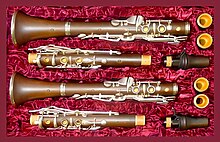|
Carl Baermann Carl Baermann (24 October 1810 – 23 May 1885) was a clarinetist and composer from Munich, Germany. Life and careerHe was the son of noted clarinet virtuoso Heinrich Baermann and Helene Harlaß. As a child he was taught the clarinet and the basset horn by his father. He played occasionally in the Munich court orchestra when he was 14 years old, and was appointed its second clarinetist in 1832.[1] When his father retired in 1834, Carl succeeded his father as principal clarinetist. He held that position until he retired in 1880.[2] He toured Europe with his father in 1827, 1832 and 1838. In 1833 they premiered Felix Mendelssohn's Konzert Stücke, Opp. 113 & 114, (Concert Pieces) to great acclaim. Carl Baermann's compositions, 88 opus numbers, were popular with clarinet virtuosos.  Baermann developed the Baermann-Ottensteiner key system for the clarinet, which was based on the Müller system. The system was very popular during the late 19th century, partly because of Baermann's Vollständige Clarinett-Schule (Complete School for the Clarinet), one of the leading methods for teaching the clarinet, written between 1864 and 1875.[3] Compositions
Carl Baermann (son) Carl Baermann had a son, also named Carl Baermann (9 July 1839 in Munich – 17 January 1913 in Newton, Massachusetts), a pianist who studied his instrument at the Royal Bavarian Music School with Christian Wanner and Andreas Wohlmuth (1809–1884), and composition with Franz Lachner and Peter Cornelius in Munich.[4] He later became a student and friend of Franz Liszt. He taught at the Royal Bavarian Music School, being made professor there in 1876. On 22 December 1881, he made his US debut as a pianist in Boston, where he remained active as a pianist and teacher. Among his students were Amy Beach, Lee Pattison, Frederick Converse, Dai Buell and George Copeland.[4][5][6] He composed a number of works for piano solo and with orchestra;[7] among his published works of the former include 12 Etüden, Op. 4 (in Offenbach by the firm Johann André, 1887) and Polonaise pathétique (1914).[4] References
External links
|